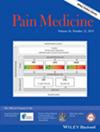音乐专业学生与专业音乐家之间与表演相关的疼痛和残疾:一项使用经验证工具的多中心研究
IF 2.9
3区 医学
Q1 ANESTHESIOLOGY
引用次数: 0
摘要
目的 评估音乐表演相关疼痛在音乐家中的流行程度,并比较音乐专业学生和专业音乐家的疼痛特征、相关残疾和疼痛治疗方法。方法 对 585 名音乐家进行多中心横断面研究,采用多阶段分层群组随机抽样,按音乐专业学生(294 人,其中 234 人在大学预科阶段,60 人在大学阶段)和专业音乐家(291 人)进行分层。主要结果是演奏相关疼痛,通过音乐家演奏相关疼痛问卷(PPAM)进行测量。次要结果包括:疼痛治疗方法、体力活动水平、疲劳、痛苦以及与健康相关的生活质量。结果 表演相关疼痛的终生患病率为 55.0%(n = 322),专业人士的患病率明显更高(57.5% 对 42.5%,p < 0.001)。专业音乐家的疼痛强度得分明显更高(p p p lt 0.05),但音乐学生的疼痛对表演的干扰更大,他们的疲劳程度(p = 0.008)和痛苦程度(p p lt 0.001)也明显更高,生活质量也更低(p p lt 0.001)。无论疼痛强度和干扰、疲劳、焦虑和抑郁程度有多高,生活质量有多低,有 33% 的音乐家在出现疼痛时从未寻求过医疗保健服务(这一比例在音乐专业学生中明显更高,为 57%,p &;lt;0.001)。结论 我们使用一种经过验证的工具,对不同背景的音乐家进行了表演相关疼痛的多中心研究,并对音乐学生和专业音乐家进行了区分。演奏相关疼痛在音乐家中是一种高发的致残性疾病,然而,其正确评估和管理往往仍未得到足够重视,从而导致严重损伤和生活质量下降。本文章由计算机程序翻译,如有差异,请以英文原文为准。
Performance-related Pain and Disability among Music Students Versus Professional Musicians: a Multicenter Study using a Validated Tool
Objective To evaluate prevalence of performance-related pain among musicians and compare pain characteristics, associated disability and approach to pain management, between music students and professional musicians. Methods A multicenter cross-sectional study was performed in a multi-stage stratified cluster random sample of 585 musicians, stratified by music students (294, among which 234 were at pre-university level and 60 at university level) and professional musicians (291). The main outcome was performance-related pain, measured by Performance-related Pain among Musicians Questionnaire (PPAM). Secondary outcomes were: pain management approach, physical activity levels, fatigue, distress, and health-related quality of life. Results The lifetime prevalence of performance-related pain was 55.0% (n = 322), being significantly higher among professionals (57.5% versus 42.5%, p < 0.001). Pain intensity scores were significantly higher in professional musicians (p < 0,05), but pain interference in performance was higher among music students, who also reported significantly higher levels of fatigue (p = 0.008) and distress (p < 0.001), and lower quality of life (p < 0.001). Regardless of the high levels of pain intensity and interference, fatigue, anxiety and depression, and low levels of quality of life, 33% musicians who developed pain had never looked for healthcare (this proportion is significantly higher for music students, 57%, p < 0.001). Conclusions We present the first multicenter study on performance-related pain among musicians with different backgrounds, using a validated tool, and distinguishing music students from professional musicians. Performance-related pain is a highly prevalent and disabling condition among musicians, however, its proper evaluation and management are still often underappreciated, contributing to significant impairments and reduced quality of life.
求助全文
通过发布文献求助,成功后即可免费获取论文全文。
去求助
来源期刊

Pain Medicine
医学-医学:内科
CiteScore
6.50
自引率
3.20%
发文量
187
审稿时长
3 months
期刊介绍:
Pain Medicine is a multi-disciplinary journal dedicated to pain clinicians, educators and researchers with an interest in pain from various medical specialties such as pain medicine, anaesthesiology, family practice, internal medicine, neurology, neurological surgery, orthopaedic spine surgery, psychiatry, and rehabilitation medicine as well as related health disciplines such as psychology, neuroscience, nursing, nurse practitioner, physical therapy, and integrative health.
 求助内容:
求助内容: 应助结果提醒方式:
应助结果提醒方式:


